Police or shelters? Here’s how Salt Lake City is using both to address homelessness
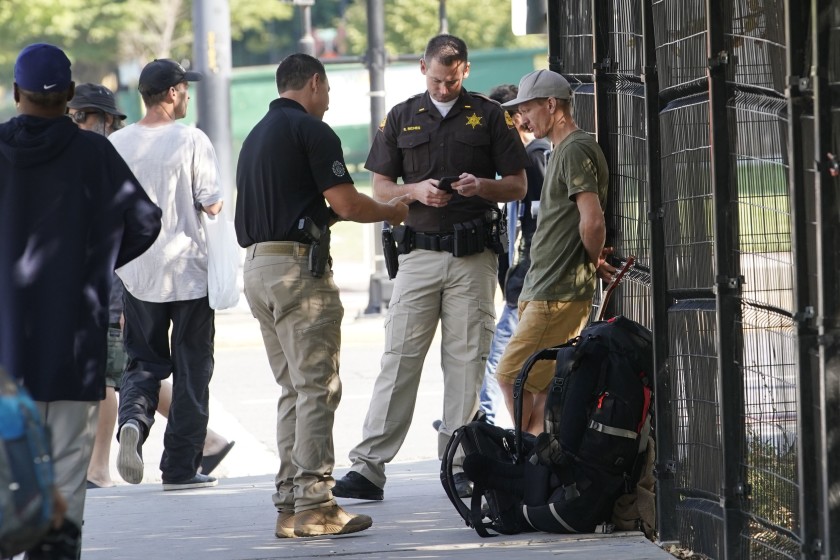
SALT LAKE CITY —
The word was out on Rio Grande Street that if you got arrested, you could get into treatment. After a two-decade slide into heroin and homelessness, Branden Jenkins was ready. He didn’t even try to hide.
“I had a needle in my arm when six police cars drove up,” the 35-year-old said.
The previous 32 times he had been arrested, Jenkins was quickly released because the jail was full. This time, in 2017, was different. He sat in a cell for two weeks, wondering if the rumors about treatment were true.
Jenkins was caught between what are frequently painted as opposite approaches for addressing homelessness — one by putting money into services and shelters to help people get into housing, and the other by resorting to a police crackdown.
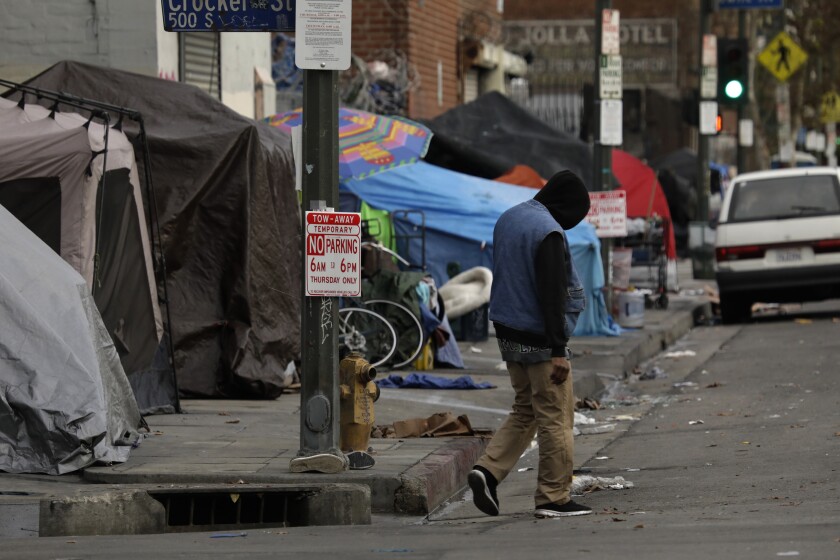
But unlike in Los Angeles, where the response to homelessness has leaned heavily toward housing and services, and law enforcement has been a lesser part of the equation, Salt Lake City has pursued both strategies equally.
And the community — the city, county, state and nonprofits — has managed to do it without running afoul of City of Boise vs. Martin, the 2018 federal appeals court decision that found it unconstitutional to punish people for sleeping on the sidewalk when there aren’t enough shelter beds or housing available as an alternative.
Last week, the U.S. Supreme Court declined to hear a challenge to the case, ensuring that the status quo, which some cities say has hamstrung their attempts to clear homeless encampments, will remain in place for Utah, California and seven other western states.
But even under Boise, Salt Lake City in two years shut down an aging 1,100-bed shelter on Rio Grande Street, The Road Home, and replaced it with three smaller ones that provide better accommodations and treatment for hundreds of people.

It has also worked with state police in a massive sweep, known as Operation Rio Grande, that has led to 7,000 arrests in an unruly community of tents and tarps around The Road Home shelter. By enforcing warrants and misdemeanor and felony offenses instead of anti-camping laws, police worked around the ruling by the 9th U.S. Circuit Court of Appeals.
While debate continues over whether the police crackdown was necessary or did more harm than good for thousands of homeless people like Jenkins, there is no disputing the result: Lawlessness and squalor around Rio Grande Street is all but gone.
“If we had to do it over, my mantra is, ‘Operation Rio Grande never again!’ because I think we could do better,” said Rob Wesemann, executive director of the Utah Alliance on Mental Health, who was not a fan of the law enforcement sweeps. “But where we are now is a pretty good spot.”
*
Salt Lake City’s journey to this new level of growing civic cooperation began in 2015, when Utah briefly seized the national spotlight by announcing that its “housing first” policy had reduced chronic homelessness by a remarkable 91%.
That glow quickly faded, though. A researcher writing for the Huffington Post debunked Utah’s claim, showing that the reported decline was derived almost entirely from a methodological change to its survey of the homeless population.
Greg Hughes, then-speaker of the state’s House of Representatives, complained that Utah had become a national joke — particularly because the expanding homeless encampments around The Road Home so obviously disproved the story. His embarrassment crystallized in 2017, when a homeless man’s assault on a visiting minor league baseball player made headlines.
Hughes parlayed the series of events into a $67-million carve-out from the state budget to deploy the Utah Highway Patrol and the state Bureau of Investigation for Operation Rio Grande. State troopers worked alongside local police, and as many as 100 officers spread out over the quadrant of southwest downtown Salt Lake City near the shelter. Within a month they made more than 1,000 arrests for offenses from jaywalking to drug dealing.
The operation, which has been extended into a third year to wind down, is popular with business owners and residents. Much like downtown Los Angeles, the downtown of this capital city is in the midst of a millennial-led economic revival bumping up against a legacy of hard-core street chaos.
“It’s like night and day,” said Max Bell, manager of the Rio Grande Cafe. Bell said he is planning to reopen a sidewalk dining area that was once overrun by panhandlers.

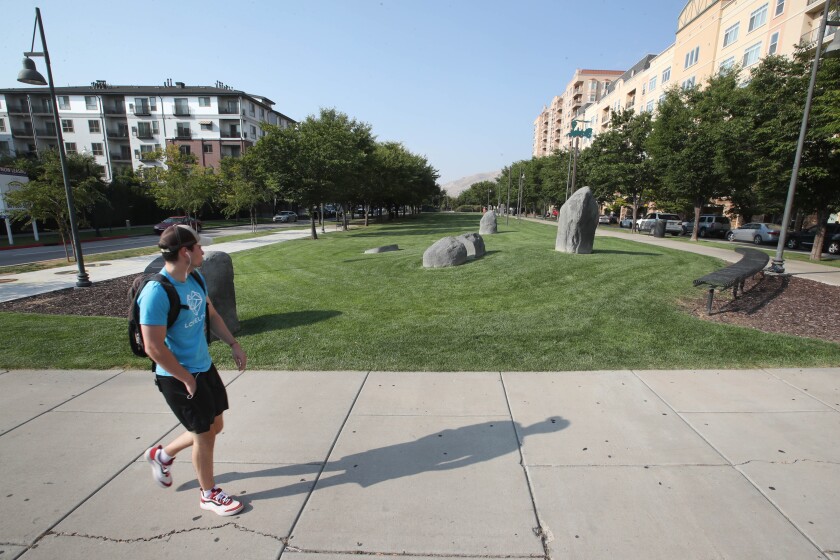
Less predictably, some of those on the front lines of serving the homeless population are also grateful for Operation Rio Grande.
“It was absolutely unsafe,” said Matthew Melville, director of Catholic Community Services day center. “Volunteers didn’t feel safe. Staff members didn’t want to come in. I had knives pulled on me. Staff members had knives pulled on them.”
Now, when he arrives to work on his bike, he’s dodging e-scooters instead of aggressive drug dealers, trying to sell to him and homeless people alike. They pushed the “street wolves out of here,” Melville said.
The American Civil Liberties Union of Utah contests that view. In a November 2018 report, it analyzed records of the first 5,000 arrests and determined that most were for low-level transgressions, such as trespassing, jaywalking and public drug use, rather than shutting down the dealers who preyed on homeless people. A follow-up released last month said the arrests had damaged thousands of lives.
“Problems created by [the] over-reliance on arrests and fines — especially for low-level crimes associated with being homeless — are becoming more apparent as public defenders, housing advocates, and social workers try to clean up the disorder it created in people’s lives,” it said. “Criminalizing the experience of homelessness can create long-lasting consequences for people without significant means, even when a person is given what many would consider a ‘slap on the wrist.’ ”
*
Even before Operation Rio Grande, some officials were exploring alternatives to prosecution.
In a pilot program, those arrested for low-level offenses were taken to a vacant bank building, where they were given a choice: Go to jail and face prosecution. Or go to treatment and no charges will be filed.
Treatment providers such as Odyssey House agreed to open new beds to accommodate the pilot program, eventually doubling the supply. The state’s registry of sober-living homes — licensed in Utah unlike in California — revealed an unused supply of long-term housing.
Noella Sudbury, who oversaw the pilot program for then-county Mayor Ben McAdams, said some homeless people took their chances in court, knowing they would be released quickly from the overcrowded jail. Those who were serious about changing their lives took treatment. The $2-million program maxed out with about 100 choosing to go into diversion, Sudbury said.
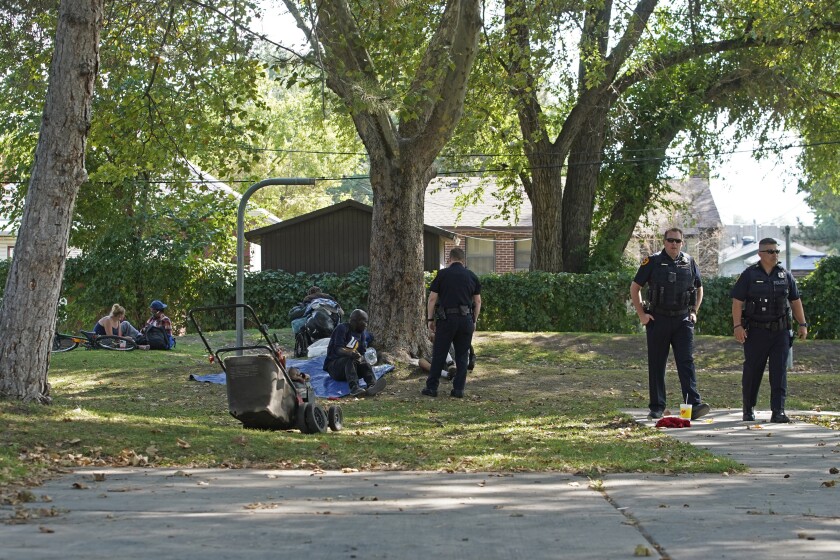
Then, with additional state funding from Operation Rio Grande, the county extended the program but hardened the rules. Newly arrested people were booked and held in cells vacated by sending inmates awaiting trial to other counties.
Every two to three weeks, a team of public defenders, prosecutors and behavioral health specialists interviewed inmates considered suitable for diversion. Those who accepted would be under court order to complete the residential program, which could then lead to permanent housing. If they completed the program, the charges were dropped.
Sudbury, who has since become a consultant helping other states set up similar programs, said the court-supervised program worked well for some homeless people suffering from addiction.
“What they needed was the structure,” she said. If they walked away, they knew a detective would come looking for them.
Jenkins was one of those homeless people. When a deputy finally told him he could get out of jail and into treatment, he chose Odyssey House because of its reputation for being the toughest — with zero tolerance, even for cigarettes. It was a grueling nine months followed by several more in a sober-living home.
Jenkins now has his own apartment, a job and hope for a future with a family. He still lives near Rio Grande Street and finds it therapeutic.
“Looking at people I used to get high with, I can no more imagine being like that again then I could back then imagine what I am today,” he told The Times.
It’s difficult to put Jenkins’ success in context, though. The Operation Rio Grande website reports that a mere 150 people pleaded into drug court and 176 entered treatment. But it doesn’t report how many completed the treatment. The website also says that 813 people had been placed in sober living homes.
In Sudbury’s view, the most significant outcome of Operation Rio Grande was the decision in 2017 to apply for an Affordable Care Act waiver. More than 4,000 homeless people have since obtained health coverage, opening a treatment avenue outside the court system.
But even if the hundreds who have gone to rehab under Operation Rio Grande all succeeded, they would account for only a small percentage of the nearly 3,000 homeless people who were arrested — many more than one time — or others who were simply pressured to leave the area.
What happened to the rest is a matter of speculation. Homeless people, apparently recognizable by their sleeping gear and bedraggled appearance, are evident throughout Salt Lake City. Officials in nearby cities have complained of spikes in homelessness.
The ACLU, in its follow-up report, contends that hundreds of people have simply cycled through the jail without receiving help, been released with new criminal records and displaced to more remote environs far from services.
Salt Lake City Police Chief Mike Brown concurs that there was dispersion.
“We didn’t solve homelessness and addiction by putting 150 cops down there,” he said. “A lot of people moved to different areas where they wouldn’t be in the light of law enforcement.”
Still, he considers the operation successful because now Rio Grande Street is an area police can handle, rather than a pit of lawlessness where “there was no restriction on what kind of drugs people used” because they knew they wouldn’t be arrested.
Operation Rio Grande commander Chief Brian Redd of the Utah Bureau of Investigation contends that many who were thought to be homeless were only there to party and have since gone back to homes they had either left or were kicked out of.
Both departments now pair police officers with social workers, and Brown and Redd say that their officers have learned to temper enforcement with empathy.
*
The Road Home shelter, which the state purchased last year from its nonprofit owners, closed in mid-November, just days after the last of the three new shelters opened several months behind schedule.
The transition proved bumpy because the three new shelters have fewer beds than The Road Home did, said Glenn Bailey, executive director of the Crossroads Urban Center, a longtime critic of the plan. Some homeless people got left out. Some were given motel vouchers and others are using the Catholic Community Services’ day center as what the state has termed a “warming center.”
As a result, Bailey said, they “come in and out through the night, sleep sitting up in a chair.”
Those entering the new shelters have had an entirely different experience.
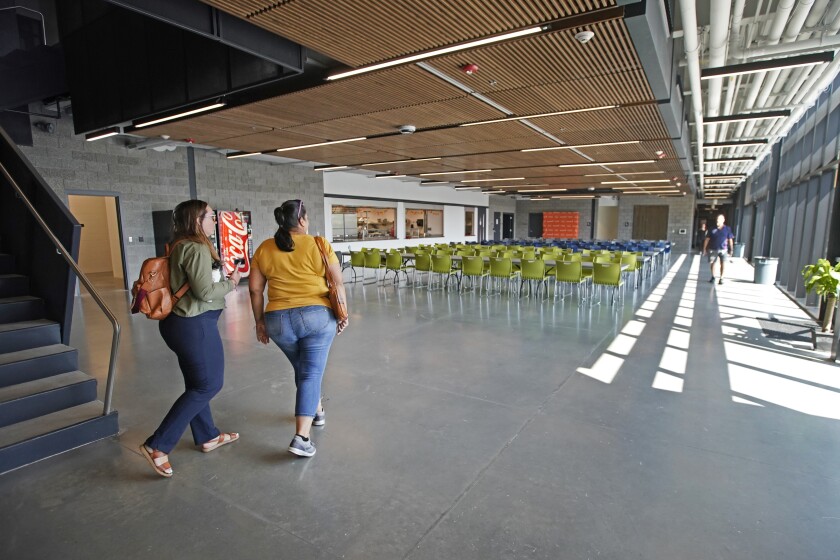
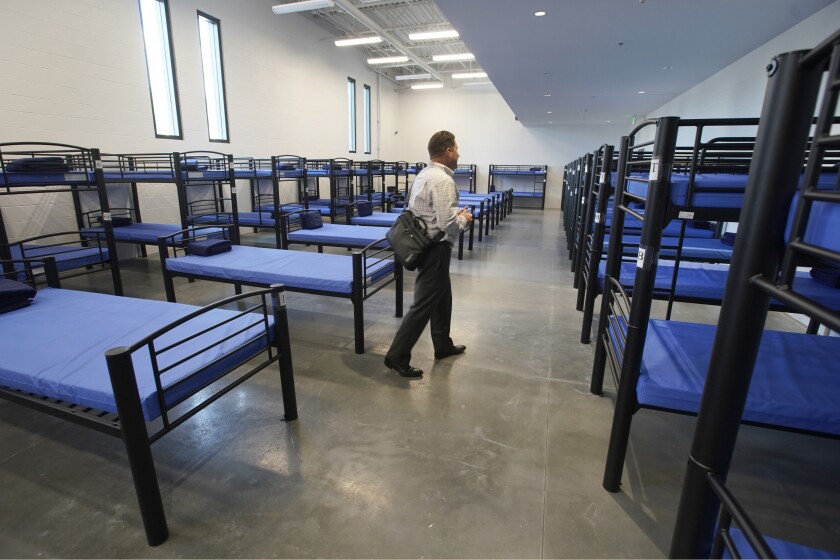
The Gail Miller Resource Center, named for the philanthropic owner of the Utah Jazz, is nothing like The Road Home or any of the other common varieties of warehouse-like shelters. Its sleeping quarters — 200 barracks-style bunks and single beds — take up only a small part of the 62,000 square-foot facility.
The largest space is filled with dozens of couches where residents can socialize. Five classrooms line one wall. And large picture windows look over landscaped outdoor lounging areas.
All three new shelters have similar amenities. And the message is clear: Being there is more about being awake than being asleep.
Shelter the Homeless, the nonprofit that owns the shelters, hopes to help people transition into permanent housing within 90 days, thus opening shelter beds for new clients.
That model could be problematic for residents who have lived at The Road Home for years. Matthew Minkevitch, who was the director there for nearly two decades, saw his mission as keeping the doors open to anyone who needed a bed for the night. Residents could stay as long as they wanted.
An even more daunting obstacle is likely to be the scarcity of the permanent housing for those leaving the shelters.
Hughes, the former speaker of the Utah House of Representatives, said that the failure to provide enough housing is his biggest regret. Like Los Angeles, Salt Lake City is producing permanent supportive housing but at a pace that will take years to fulfill the need.
*
After two years, Operation Rio Grande has reached a plateau. Arrests, which spiked in its first few months, have declined. Reported crimes dropped about 50%, then leveled off. But the future of the neighborhood is still in flux.
The state, which owns The Road Home property, is planning to sell it, possibly to become a mixed-use development consistent with the upscale shopping mall across the street and several new residential buildings.
But Catholic Community Services is not only staying, it’s invested $1.2 million into an expansion and will cook meals seven days a week for the three new shelters.
“We own the land, we’re committed to this area,” Melville said. “We’re going to stay and have our commitment to helping people that don’t access the resource centers.”
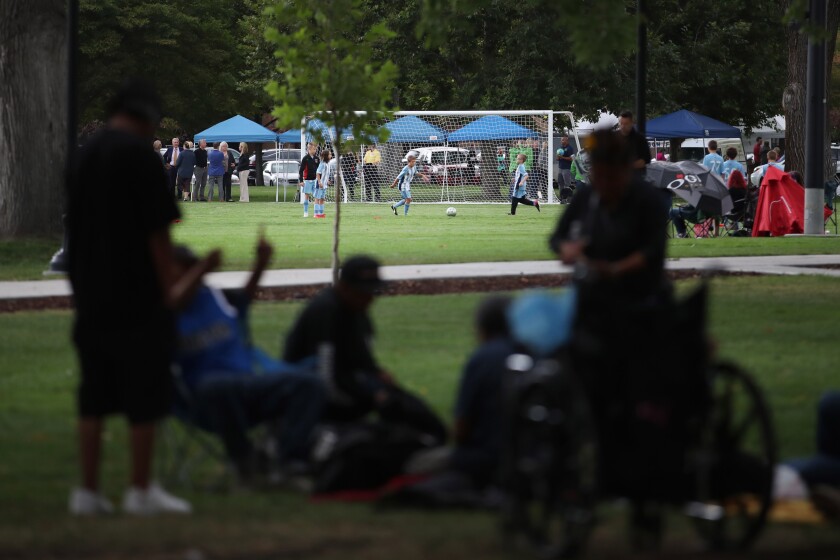
What lies ahead may be foreshadowed by the transformation of Pioneer Park, a 10-acre square one block from the Rio Grande transit station that has long been a hangout for transients. Under pressure, the city has launched a multi-million rehabilitation. In September, the first phase was completed with a new soccer field. The Pioneer Park Coalition, a group of business owners and residents, raised $300,000, including a donation from Gail Miller.
Mayor Jackie Biskupski christened the new field in September, kicking a ball around with her son.
Then, a dozen or so men moved to the sidelines and watched as a youth soccer club took over.
 Pathways Drug Rehabilitation Luxury Addiction Treatment & Detox Center
Pathways Drug Rehabilitation Luxury Addiction Treatment & Detox Center



